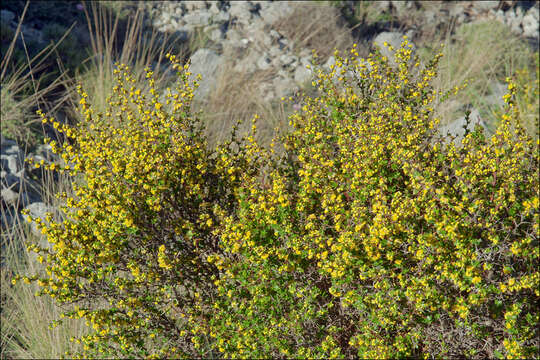Berberis-cretica_6

Description:
Berberis cretica L.Cretan Barberry, DE: Kretische BerberizeSlo.: kretiki eminDat.: April 26. 2016Lat.: 35.36129 Long.: 23.90723Code: Bot_951/2016_DSC1714Habitat: light mountain cypresses woodland (Cupressus sempervirens), north oriented mountain slope, locally almost flat terrain; calcareous, rocky, skeletal ground; full sun; elevation 1.030 m (3.400 feet); average precipitations ~ 1.000 mm/year, average temperature 8-10 deg C (estimated ?), Mediterranean phytogeographical region. Substratum: soil.Place: Northwest slopes of White Mountains, north of Omalos plateau, next to the road from Omalos village to north shore of the island, somewhat lower after the highest point of the road; West Crete, Mediterranean Sea, Greece EU. Comment: Berberis cretica is a beautiful plant when in bloom, however adversely spiny. Its three-partite long and sturdy spines are dense and very sharp so it is impossible to brake off a single small branch with bare hands. This is, of cause, an efficient defense against grazing goats, which have radically changed Cretan flora through last millennia. Most of plants of Phrygana, specific Greek type of Garrigue (an open community of dwarf evergreen shrubs) are thorny.Berberis cretica is limited to high mountains of Crete, Rhodes, south Greece and Turkey. Contrary to our central European Common Barberry (Berberis vulgaris), which has vividly red berries, it has dark blue, almost black berries.Ref.:(1) I. Schnfelder, P. Schnfelder, Kosmos Atlas Mittelmeer- und Kanarenflora, Kosmos, (2002), p 48.(2) V. Papiomytoglou, Wildblumen aus Friechenland, Mediterrane Editions (2006), p 24.
Included On The Following Pages:
- Life (creatures)
- Cellular (cellular organisms)
- Eukaryota (eukaryotes)
- Archaeplastida (plants)
- Chloroplastida (green plants)
- Streptophyta
- Embryophytes
- Tracheophyta (ferns)
- Spermatophytes (seed plants)
- Angiosperms (Dicotyledons)
- Eudicots
- Ranunculales (Red Columbine)
- Berberidaceae (barberry family)
- Berberis (Barberry)
- Berberis cretica (Cretan Barberry)
This image is not featured in any collections.
Source Information
- license
- cc-by-nc-sa
- copyright
- Amadej Trnkoczy
- photographer
- Amadej Trnkoczy
- original
- original media file
- visit source
- partner site
- Flickr Group
- ID


